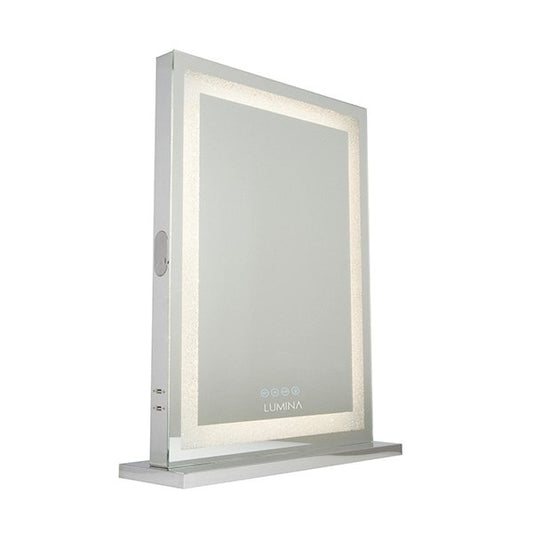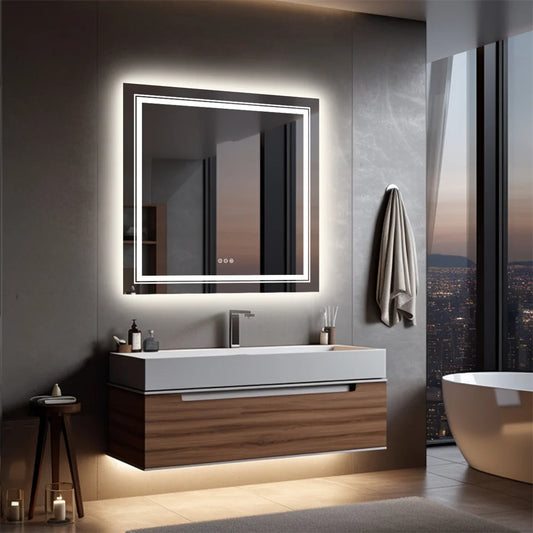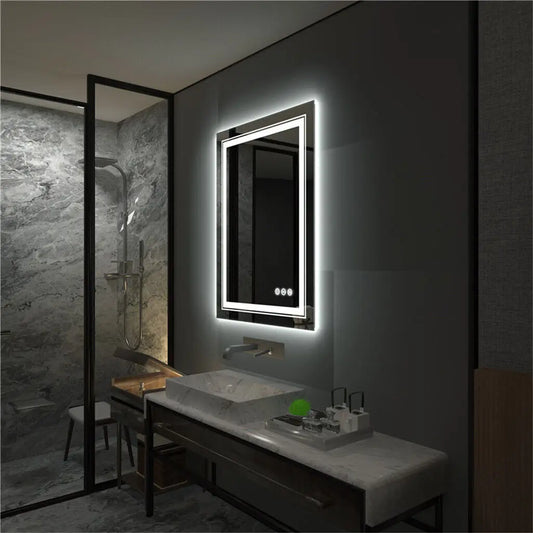Vanity mirrors can be expensive. People in the USA can spend upwards of $300, or even $1,000, on these mirrors. Understandably, the regret that follows an unwise purchase is likewise quite…significant.
One of the things that people can struggle to correctly pick is the size. By not properly measuring the size of the vanity and the wall space, people can end up buying a vanity that is too large or too small.
If you want to avoid making this same mistake during your purchase, you are at the right place. We’re going to help you pick the best vanity mirror size in this article.
Let’s get started.
Understanding Vanity Mirror Dimensions
To start off, let’s acquaint ourselves a little bit with the basics of vanity mirror dimensions and how people usually make their choices in this regard.
What are the usual sizes for vanity mirrors?
Here is a list of the typical vanity mirror sizes that people buy and use.
- 24" W x 30" H
- 30" W x 36" H
- 36" W x 30" H
- 48” W x 30” H
Usually, the width of the mirror is around 24 to 36 inches, while the height can be from 30 to 48 inches. Between these, there are various sizes that people choose and use in their homes.
What are these sizes best for?
Here is a table that shows the ideal use case for each of the sizes mentioned above.
| Mirror Size (W x H) | Best For |
| 24" x 30" | Small bathrooms or powder rooms with compact vanities; they can also be used in a double-mirror configuration for large bathrooms |
| 30" x 36" | Standard single-sink vanities |
| 36" x 30" | Wider single vanities; works well where vertical space is limited |
| 48" x 30" | Double-sink vanities or long single-sink setups; ideal for shared bathrooms |
(If you are also thinking of buying a vanity and aren’t sure of the perfect size, you can check out this blog we wrote on the ideal vanity table dimensions.)
How big should the mirror be in relation to the vanity?
Next up, here is another important question that you need to ask yourself.
What should be the proportion of the mirror in relation to the vanity size and the wall space?
The mirror should be 1 – 2 inches shorter than the vanity on both sides. If the vanity is 45 inches wide, the mirror should end around 1 or 2 inches before it on either side. The mirror, in this case, would be around 41 to 43 inches wide.
Below is an image that shows the ideal mirror length in relation to the vanity:

Custom vs. Standard Mirrors: When to Choose Which?
Standard mirrors have measurements similar to the ones we mentioned above. However, in certain situations, the standard sizes are not suitable. For example, if the vanity happens to be too large or too small, then you have to go with a custom mirror size.
If you have a normal-sized vanity table, you should buy a standard mirror. The benefit of buying a standard mirror is that they are easy to acquire and don’t come with any additional costs.
On the other hand, custom mirrors, while fulfilling your specific needs, can come at a higher price tag.
Framed vs. Frameless Mirrors: Understanding the Differences
When choosing mirror dimensions, another factor to consider is the frame.
A frameless mirror doesn’t have a border. It stretches from one edge to the other without any boundary or bezel.
On the other hand, a framed mirror comes with a frame around the edges. The frame can be made of wood or steel, or any other similar material.
Depending on which one of these options you want, your size considerations will be different. A 30-inch framed mirror will look a lot different than a 30-inch frameless mirror. The latter will have a bigger viewing surface, and a large-sized one would overwhelm a small vanity space. On the other hand, a framed mirror of the same size would look more balanced, as the size would include the frame as well.
This is the main difference between these mirrors with regard to choosing the perfect vanity mirror size.
Before we move on, here is a table showing the pros and cons of both of these mirror types. (Although we’ve already mentioned the bearing that these styles have on the mirror size, the pros and cons below will further help you make the right choice between them.)
| Feature | Framed Mirrors | Frameless Mirrors |
| View | Slightly obstructed due to the presence of the frame | Maximum viewing surface |
| Style/aesthetic | Traditional and fancy | Minimalist, sleek, and modern |
| Materials | A combination of two or more materials, such as wood, steel, and glass | Usually only made of glass due to a lack of a frame |
| Cleaning and maintenance | Difficult due to the presence of the frame, which can trap dust particles and make corner cleaning hard | Simple and easy wipe-downs are all you need |
| Durability | Framed mirrors are hardy and durable due to their robust construction | Frameless mirrors are not as durable due to their glass-only construction |
Mirror Shapes and Styles: Their Impact on Ideal Size
Just as the frame (or lack thereof) on a mirror can make a difference in the ideal size, there are other style elements that play a similar role.
For example, if a particular mirror is equipped with LED lighting along with frosted edges, the total size wouldn’t be truly indicative of the total viewing surface. Since the LED lighting and the frosted edges would be on the mirror itself, you would ultimately be left with a smaller viewing surface. (More on lighting considerations later on in this post.)
Apart from the styles, the shapes of the mirror also impact the ideal size. For example, an oval-shaped mirror can have large dimensions, but the size can look reasonable once installed. A circular mirror can also be quite large in total diameter, but due to the shape, it won’t overwhelm a small vanity space.
Below, we’ve created a table that describes the various style elements in vanity mirrors as well as the typical shapes, along with their effect on the size considerations.
Here is a detailed guide on Ideal Vanity Light Height
| Style/Size | Description | Effect |
| LED Lighting + Frosted Edges | Built-in backlights or decorative edges integrated into the mirror | Shrinks usable mirror area; adds perceived size; needs space to avoid visual overcrowding |
| Bevelled Edges | Angled cut around the perimeter of the glass | Adds elegance; slightly reduces the viewing surface; ideally large to ensure a proper view + aesthetics |
| Etched or Patterned Glass | Decorative designs etched into the mirror surface | Adds style but may interfere with full reflective utility; best for aesthetic use and requires space |
| Antiqued/Distressed Finish | Weathered or aged look often with tints or mottling | May reduce reflectivity; viewing surface is much smaller than total dimensions |
| Oval Shape | Soft, elongated, round form | Appears gentle and non-intrusive even in larger sizes |
| Circular Shape | Symmetrical, fully round | Visually balanced and stylish, large diameters may still feel compact |
| Arched Top | Mirror with a rounded or pointed top (often vertical) | Adds vertical height without overwhelming width; suits classic or traditional aesthetics |
Single vs. Double Mirrors
The ideal vanity mirror size for your particular space also depends on whether you are buying a single mirror or a pair.
Double mirrors work great in vanity spaces, especially in bathrooms with a double-sink or shared vanity setup. They can add a touch of style to the place and also provide better functionality.
With double mirrors, there is also more flexibility in the proportions that we mentioned earlier. Double mirrors can line up, or even extend beyond the vanity, and still look good.
For example, in a space where a 30” single mirror would have looked suitable, you can get away with two 20” double mirrors, despite the fact that their combined width is more than the single.
Here is an image that shows just how this can practically appear:

In the image above, you can see that a double mirror arrangement can look fine, being right on the edges of the vanity. However, a single mirror has to adhere to the 1 – 2-inch shorter proportion.
Other than the size considerations, there are various pros and cons of both of these mirror types that you should consider. We’ve listed them below for your convenience.
| Feature/Aspect | Single Mirror | Double Mirrors |
| Visual Style | Sleek and minimalist | Balanced and stylish |
| Symmetry | Good for centered sinks | Ideal for double sinks or shared vanities |
| Space Flexibility | Limited—best kept within 1–2” of vanity edge | More flexible—can extend beyond vanity width |
| Installation | Easier and faster | Requires precise placement and alignment |
| Functionality | Great for solo use | Better for multiple users simultaneously |
| Cost | Typically more affordable | May be costlier (2 mirrors + extra hardware) |
| Cleaning and maintenance | One surface to maintain | More surfaces to clean |
Lighting Considerations and Preferences
Another important thing to consider when choosing the ideal size of your vanity mirror is the lighting.
There are different types of lighting that you can choose for your vanity mirror. Here is a list of some of them:
- Wall-mounted sconces: Wall-mounted sconce lights are typically installed on the sides of the vanity. These lights provide a decent amount of illumination for your makeup needs, but most of the time, they are preferred for their “decorative” role.

Image created by Sora AI for illustrative purposes
- Overhead lighting: Overhead lighting is installed at the top of the mirror. It can consist of light bulbs or LED strips. The illumination provided by these lights is better than the side sconce lights, but it can create unsightly shadows.

Image created by Sora AI for illustrative purposes
- LED light strips: LED light strips are installed around the back of the mirror. The illumination they create leaks out from the back and comes to the front. Some mirrors have a frosted edge that allows the light to bleed through and provide greater illumination. This type of lighting is great as it provides even lighting so that you don’t miss a spot.

Image created by Sora AI for illustrative purposes
You could be wondering: what bearing does my lighting preference have on the mirror size I should pick? Here is the answer.
Depending on which lighting you choose, you will have to make certain considerations for the wall space. You will have to adjust the mirror size so that you have enough available space for the lights.
For side lighting, you will need to leave enough space on the wall on either side of the mirror. On the other hand, for overhead lighting, you will need to leave space on top of the mirror so that the light unit can be easily installed.
As for LED backlights, they can make the mirror look bigger. Even if the mirror is small, the lighting can make it look overwhelming. It can dominate the vanity space.
If you’re going for LED backlighting, make sure that you have enough room in the vanity space to easily accommodate the mirror along with the bright glow.
How to Measure Your Vanity and Wall Space
Let’s move on to how you should measure your vanity and wall space. After taking these measurements and keeping the other factors in consideration (the ones we’ve discussed earlier), you will be able to make the perfect choice for your mirror size.
- Use a tape measure to measure the vanity from end to end. When measuring, stick to the top surface of the vanity, and discount any holders or brackets installed on the sides.
- Measure the height of the vanity. This will be useful for when you’re installing the mirror itself. Measure from the floor to the highest extremity of the vanity.
- Next, measure the wall space around your vanity. If there are any fixtures nearby, such as lights or overhead cabinets, etc., note them carefully. This will help you install the mirror without any hassle later on. When measuring the wall space, make sure that you have space for the lighting (if any).
After taking these measurements, look for a mirror that is proportionate in size to the vanity. Pick the lighting options as per the wall space you have available.
Height and Placement Tips
Moving on, let’s take a look at some height and placement tips.
What is the ideal height for mirror installation?
The ideal height for a mirror is about 5 feet above the ground. In other words, the center of the mirror should be about 5 feet above the ground. For most adults, this height will provide a sufficient view.
Of course, this would not hold true for small mirrors. For smaller mirrors, an eye-level installation can work well. This applies to the really small, compact ones.
As for the vanity, the mirror should be installed about 5 to 10 inches above it. This helps to create a balanced visual flow between the vanity and the mirror. This spacing prevents the mirror from looking cramped and allows for adequate lighting, whether it’s built into the mirror or positioned around it.
Align according to your height
The measurements mentioned above are for people of average height. For shorter or taller individuals, the ideal installation can vary.
You should adjust the mirror installation so that it is roughly at eye level and gives you a complete view of yourself.
Make Sure to Match Mirrors to the Bathroom Style
At first glance, the bathroom style may not seem to have the biggest bearing on ideal mirror size. However, there is a connection.
If your bathroom’s style leans towards minimalism, a small or medium-sized mirror would look at home with the entire theme. On the other hand, if the style leans towards maximalism, then a bigger mirror would look more suitable.
Along with size, the style of the bathroom also impacts whether you should go for a double mirror setup or a single mirror. A shared vanity or a luxurious, more ornate style often calls for dual mirrors. Single mirrors, on the other hand, suit streamlined, modern designs better.
The bathroom style can also affect your choice of going for a framed or frameless mirror. Minimalist and modern bathrooms usually agree with frameless mirrors, while framed mirrors go great with traditional bathroom styles.
You should keep your bathroom’s existing style in mind right from the outset, so that you can make decisions in accordance with it.
Installation Tips
Here are some more installation tips that you can follow to make sure that everything goes smoothly.
- When installing the mirror, make sure to secure it to the studs in your walls and not just the drywall. This helps to make sure that the mirror stays in place and doesn’t fall off. If the mirror is not large enough to reach two studs at once, at least one end should be secured to a stud while the other can be secured using a drywall anchor.
- If you are using adhesive tape to secure the mirror, carefully wipe down the entire wall beforehand. This helps to clear away any debris that could affect the adhesiveness.
- Use a level to make sure that the mirror is installed evenly and not askew. Check the level before driving the anchors/screws home so that you can easily make adjustments.
Common Mistakes to Avoid
Here are some mistakes that people can make when installing their mirror. Try not to make any of these mistakes yourself, or it can cost you dearly.
- Relying only on drywall. If you make this mistake, your mirror could fall off, taking away bits of drywall with it. The weight of the mirror can become too much for the drywall over time. This is why it is very important to at least anchor one side of it to the stud.
- Using weak wall anchors. When installing mirrors, it is important to use strong anchors that are rated for heavy weights. Using weak anchors can result in the mirror falling off.
- Installing the mirror far away from an outlet. If you install the mirror far away from an outlet, the wiring for the lighting can become an eyesore. It’s something that many people only realize once the mirror is up and installed.
FAQs
What size mirror for 48-inch vanity?
For a 48-inch vanity, it is ideal to get a mirror that is 30 – 42 inches wide and 20 – 24 inches tall. With these dimensions, you will be able to match the mirror to the vanity while leaving room on the sides.
What size mirror for 18-inch vanity?
The ideal mirror size for an 18-inch vanity is 14 to 16 inches wide and 24 to 30 inches tall. This size ensures that the mirror remains narrower than the vanity for a balanced and aesthetic look, while still offering ample viewing space for everyday use.
What size mirror for 60-inch vanity?
For a 60-inch vanity, it is best to get a mirror that is around 48 inches wide and has 30 – 36 inches of height. This way, you will be able to follow the golden rule of keeping the mirror shorter than the vanity on both sides.
What size mirror for 30-inch vanity?
For a 30-inch vanity, a 24-28-inch wide mirror can be perfect. You should avoid going for a larger mirror as it can spoil the aesthetics of your space.
What size mirror for 36-inch vanity?
For a 36-inch vanity, a square mirror measuring 24 to 30 inches on all sides is a good choice. The square shape, in this case, helps to maintain a balanced look. A rectangular mirror can look a bit overwhelming for a small 36-inch vanity.
What size round mirror for 32-inch vanity?
If you want to buy a round mirror for a 32-inch vanity, a diameter of 26 inches to 28 inches is suitable. Round mirrors tend to look balanced even when they are large in size. That is why even a short disparity between the vanity and mirror size can work well.





